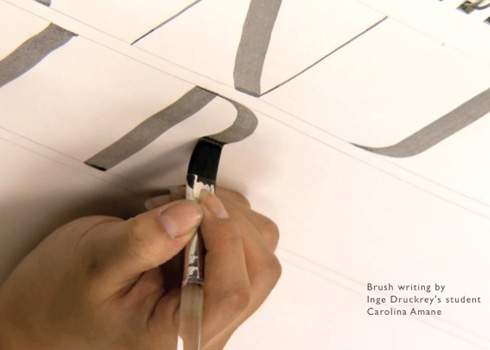Teaching to See
There’s a difference between looking and seeing. Teaching to See explores the work of designer and educator Inge Druckrey.
There’s a difference between looking and seeing. It requires practice, but there is a delicious clarity in just perceiving something, without applying any kind of conceptual filter. Just seeing, before labels or emotions or meaning.
Learning how to see is the foundation of great design, and teaching that skill is the intention of Inge Druckrey. For more than 40 years Druckrey’s been instructing at a number of schools in the US including Yale, the Rhode Island School of Design and University of Hartford. Now available is Teaching to See, a 38-minute documentary about Druckrey’s work, on Vimeo and at the website of the University of the Arts in Philadelphia where she’s the Professor Emerita of Graphic Design. The documentary emphasizes design quality through education by looking specifically at the way fonts are created, and is a considerate look at Druckrey’s process. I’m sure it also functions as a great recruiting tool to attract people considering enrolling in the University of the Arts School of Design.
Through the testimonials of former students, including designers Chris Myers and Ken Carbone, as well as through Druckrey’s voiceover paired with images, we get down to the basics of good design.
“Training the eye is very, very important,” says Druckrey, discussing appreciation of the abstract, form before content. “You can’t come up with ideas if you don’t see first.” Getting good at seeing requires conscious repetition, drawing things over and over until the understanding is internalized.
And that takes time. The film emphasizes the rigor necessary for really seeing something, and to then represent its equivalent on the page. “I can’t tell you how frustrating it was until I got it,” says Carbone about his efforts to accurately draw things, whether a freehand cube or a bottle on a table. “It could be very trying at times, but also very satisfying once you got it. Once you do, and you’ve done it yourself without someone taking your hand and making you do it, you absolutely never forget it.”
There’s also the observation that vision can deceive, in the difference between geometrical accuracy and optical accuracy in the weight of letters, for instance. Stepping back and looking at the whole, considering the negative space, is essential. Holmes describes how the eye looks for order and patterns, how conservative it can be, while the hand—what she calls “The Radical Hand”—wants to write quickly and expressively.
The film even finds room to include a moment from Steve Jobs’ famous 2005 Stanford commencement speech. He credits a calligraphy class for helping him appreciate typography and later applied those lessons to the design of the Macintosh computer.
More than once, Teaching to See emphasizes finding joy in the clarity of perception. Druckrey quotes legendary Swiss-born photographer and designer Herbert Matter, who told her, “If you love something, the work will be just fine.”






